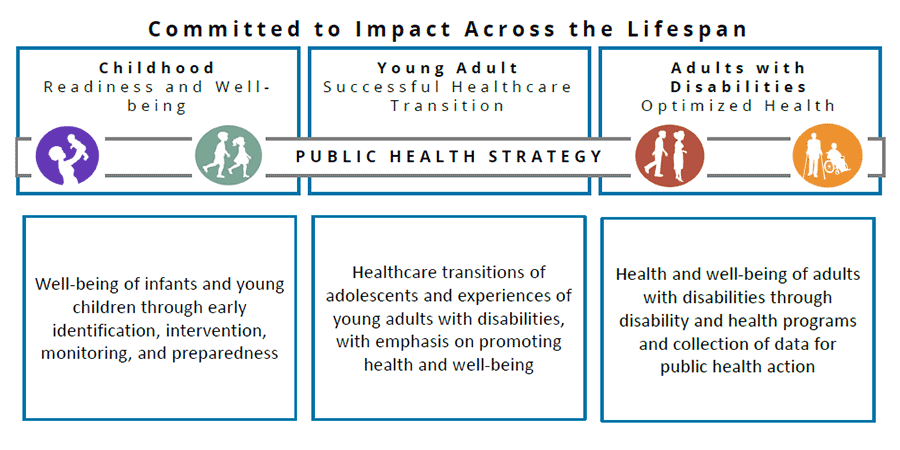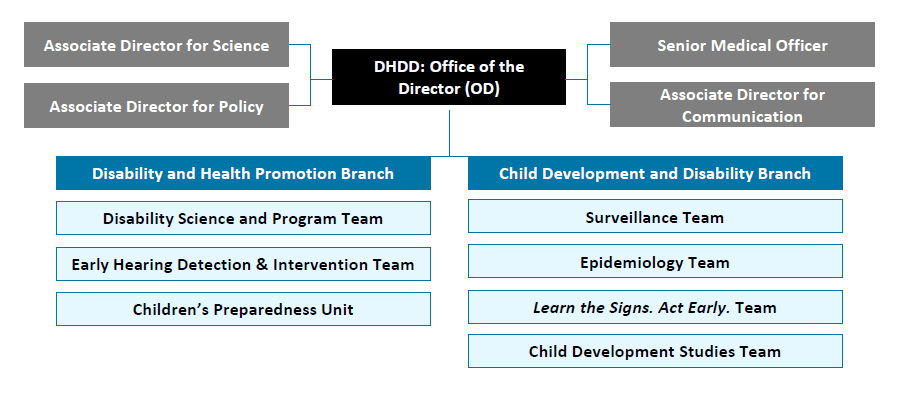DHDD Strategic Plan: About the Division
‹View Table of Contents
The Division of Human Development and Disability (DHDD) works to promote health, reduce health inequities, and help people living with disabilities fully participate in all aspects of daily life. DHDD plays a unique and important role as a public health leader in the human development and disability space, striving to provide inclusive and effective public health services to those with, or at risk for, disabilities. DHDD’s public health strategy includes the application of data, surveillance, research, partnerships, communications, and policy to advance its goals. DHDD deploys this strategy in all its work across the lifespan for addressing human development and disability needs (see Figure 1).
Based on its FY2020 appropriations, DHDD is funded to advance a variety of areas in human development and disability, including autism spectrum disorder (ASD), health among people with mobility or intellectual disabilities, Tourette syndrome (TS), Early Hearing Detection and Intervention (EHDI), attention-deficit/hyperactivity disorder (ADHD), and fragile X syndrome (FXS).
Figure 1: Lifespan Graphic
DHDD’s work, goals, and objectives strive to provide equity to people with, or at risk for, disabilities throughout their lives by leading inclusive programs, surveillance, and research in the key milestone areas listed below

Committed to Impact Across the Lifespan
Public Health Strategy
Childhood – Readiness and Well-being
- Well-being of infants and young children through early identification, intervention, monitoring, and preparedness
Young Adult – Successful Healthcare Transition
- Healthcare transitions of adolescents and experiences of young adults with disabilities, with emphasis on promoting health and well-being
Adults with Disabilities – Optimized Health
- Health and well-being of adults with disabilities through disability and health programs and collection of data for public health action
DHDD Organization Structure

CDC is the country’s leading public health agency and one of the major operating components of the U.S. Department of Health and Human Services (HHS). CDC comprises work units that focus on a set of specific public health missions given their unique capabilities and areas of expertise.
DHDD is part of CDC’s National Center on Birth Defects and Developmental Disabilities (NCBDDD), which was established in April 2001 as a result of the Children’s Health Act of 2000 to address gaps in public health resources. The Center includes three divisions: the Division of Birth Defects and Infant Disorders (DBDID), the Division of Human Development and Disability (DHDD), and the Division of Blood Disorders (DBD).
NCBDDD and its three divisions work to address the public health needs for particularly vulnerable populations. DHDD includes two branches led by the Office of the Director (OD) as seen in Figure 2. The two branches and OD work collaboratively to advance the goals of the Division. For more information on CDC’s mission and organizational structure, visit the website www.cdc.gov/about.
Figure 2: DHDD Organizational Chart
DHDD staff is composed of public health experts that sit within the Division’s branches and its OD

DHDD: Office of the Director (OD)
- Associate Director for Science
- Associate Director for Policy
- Senior Medical Officer
- Associate Director for Communication
- Disability and Health Promotion Branch
- Disability Science and Program Team
- Early Hearing Detection & Intervention Team
- Children’s Preparedness Unit
- Child Development and Disability Branch
- Surveillance Team
- Epidemiology Team
- Learn the Signs. Act Early. Team
- Child Development Studies Team